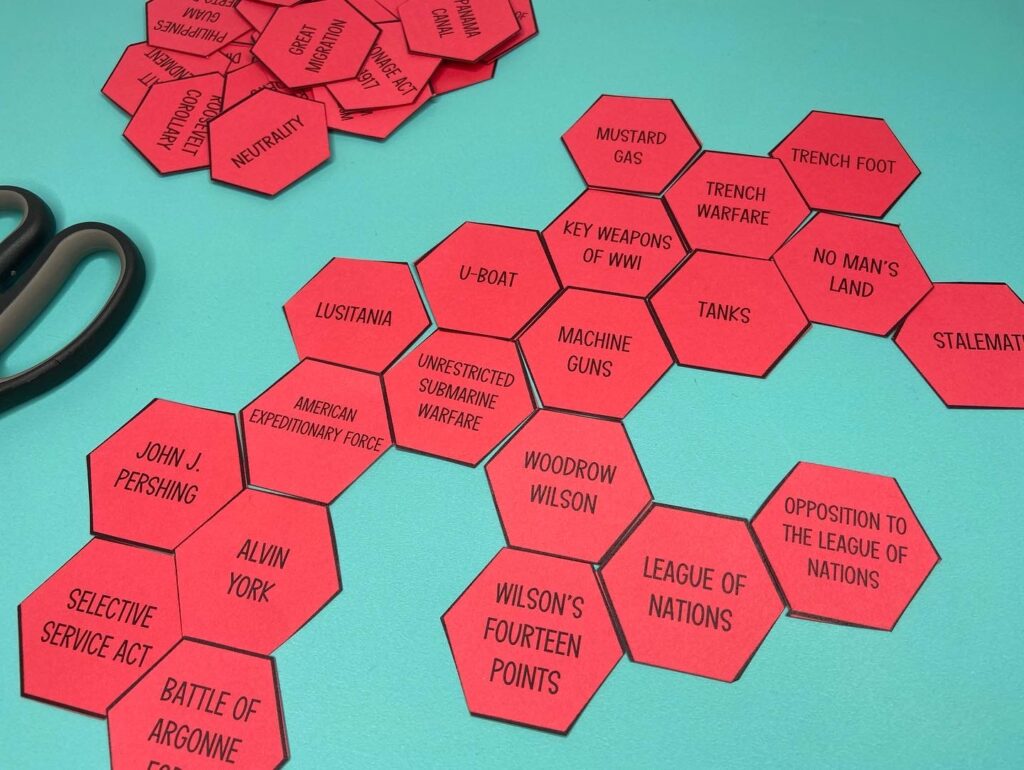
Hexagonal Thinking is a game changing activity when it comes to US History Review time! If you are looking for a way to have your students make connections between concepts in US History and think critically in a hands-on, active way, it’s time to try Hexagonal Thinking!
Have you been there?
You’ve taught quite a bit of content to your students. You look out and wonder, “are they getting it?” If this is you, it’s time to break out with a Hexagonal Thinking activity.
What is Hexagonal Thinking?
Students match up six-sided hexagons and make connections while reviewing content. By making connections between different concepts, students can gain a more well-rounded understanding of the material and retain it more effectively.
After learning about Hexagonal Thinking from the Cult of Pedagogy, I have made some modifications to fit my US History classroom.

My tips implementing hexagonal thinking:
- Identify the key concepts that need reviewing: Consider the history, culture, economics, and politics of a unit. Don’t forget to include people, battles, documents, dates etc!
- Consider multiple perspectives: Hexagonal thinking involves considering multiple perspectives, so try to think about the issue or topic from different angles. Add Hexagons to reflect multiple perspectives.
- Make connections between units. If you are near the end of the year, add hexagons that can connect to modern content. Example: connecting the 1st amendment to various court cases in the Vietnam or Civil Rights Era.
Teacher Prep:
- When I create a set of Hexagons like this one on the Civil Rights Era, I copy them off on card stock and make each set a different color.
- I put students in groups of 3 or 4 when we do this activity. By copying the hexagons on different colored card stock, when a student drops a card on the floor, I know which bag to store them in!
Cutting them out:
Let’s be honest, this is the only hard part of making a Hexagonal Thinking activity. I suggest using help from your student council, National Honor Society or any student organization that needs volunteer hours! If that doesn’t work, offer chocolate to your friends or spouse.
How to “play” in your classroom:
- After creating your baggies full of hexagons, put your students in groups of 3 or 4.
- You can either tell students what hexagon to begin with or let them pick one randomly. A “general” term works best to begin with.
- I tell students to each pick up 8 hexagons to begin with. These become “their cards” to play.
- After the initial middle hexagon is placed in the middle of their table, students take turns connecting a hexagon to one already on the table. They must JUSTIFY/EXPLAIN their connection to their group.
- When a hexagon is placed that touches multiple sides, it must “work” with all sides and be explained.
- I require my students to hold each other accountable. If a student places a hexagon and one side really doesn’t belong, group members need to speak up and encourage them to find another location.
- If a student cannot play with the hexagons in their hand, they may draw a new card from the extra cards available.
- My students are very competitive. The “winning” team (if you want to make this into a competitive game) is the team that plays all of their hexagons and can justify them all!
Assessment?
For me, the activity itself is the formative assessment. As I walk around the room, I hear their high level connections via their conversations. If you want a more concrete assessment, you can have students turn connections into a summary writing assignment. You could also have students use post-it notes to annotate their thinking.

Do you need to review for an End-of Course Exam?
Hexagonal thinking is a great way to review for your US History EOC exam. I am a huge advocate for hands-on review, rather than worksheets. Students really love Hexagonal thinking and say it’s an effective way to review!
If you love the idea of Hexagonal thinking, but don’t want to take hours and hours creating your own, save time by checking out my US HIstory Hexagons! Print and go!

Overall, hexagonal thinking encourages students to engage in active learning, which can help them to think critically and apply the knowledge they have acquired. Students love it and you will love seeing the connections they make!
This post contains affiliate links.
